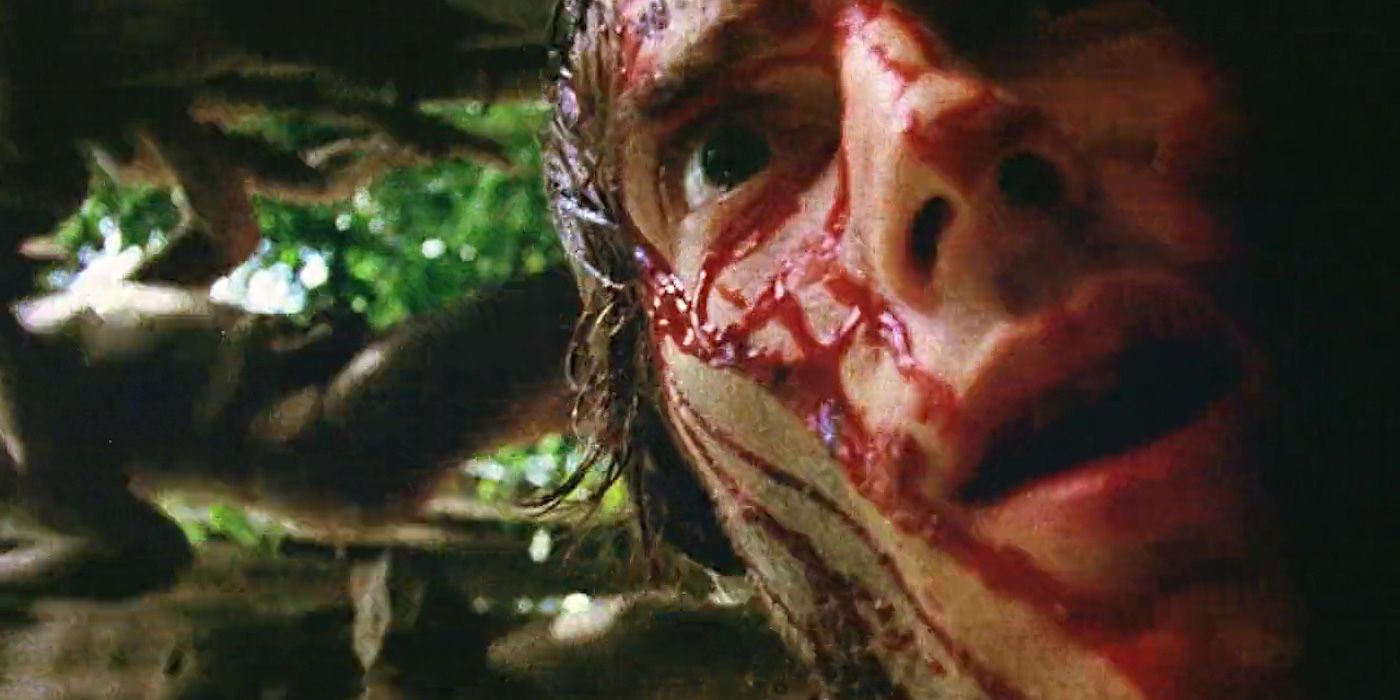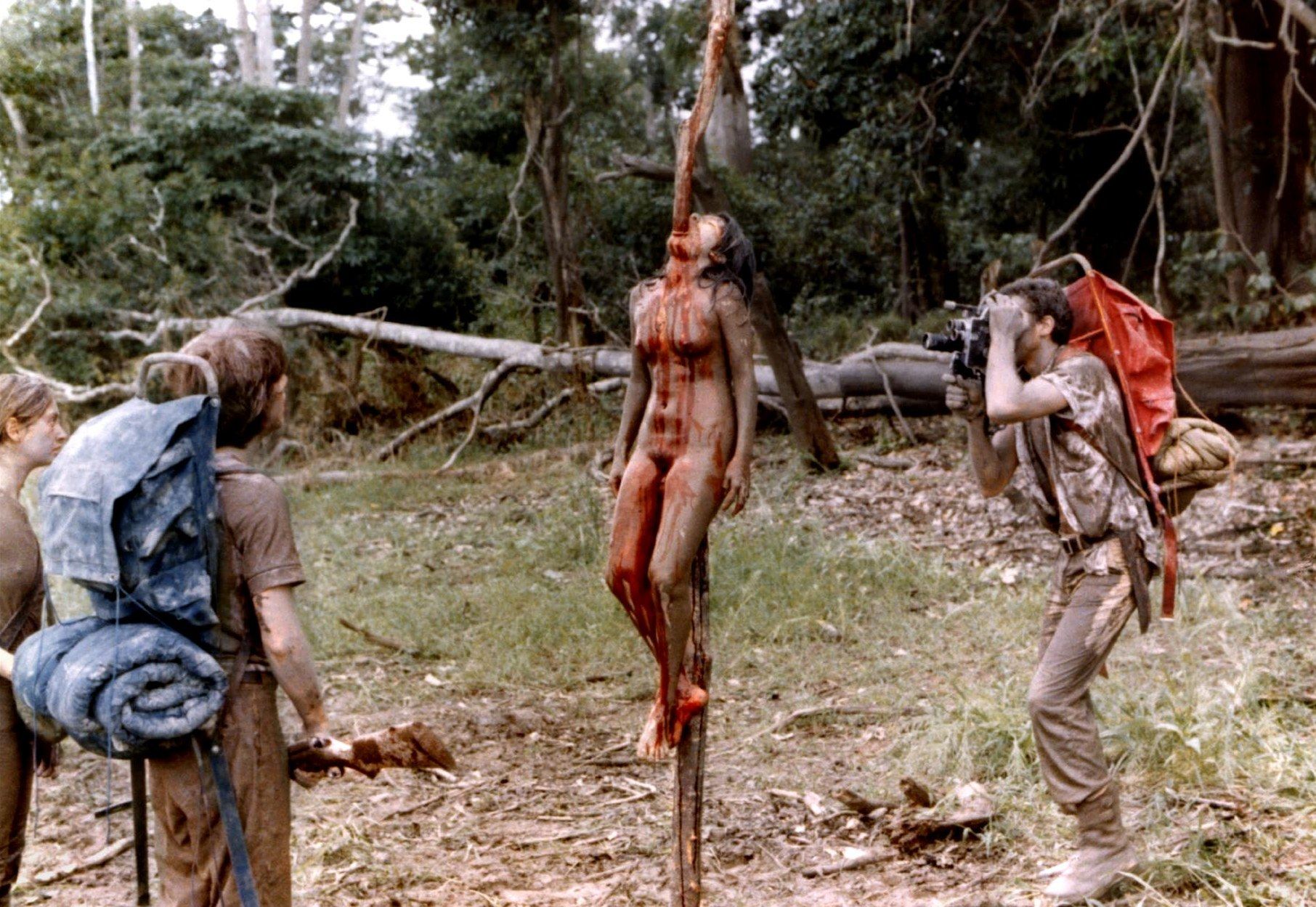Editor's Note: In honor of director Ruggero Deodato's passing today at age 83, we are republishing this review of Cannibal Holocaust, the director's most notorious film. It is gruesome, it is hard to watch, and it has quite a history behind it, which you can read about here. What was once only available as a blurry, illegally copied bootleg (and is still banned in many countries) is now available on shiny 4K Blu-ray. At least Deodato got to see his creation be appreciated.
If one were to mention the 1980 horror film Cannibal Holocaust in casual conversation, especially to those not steeped in exploitation cinema, you’re likely to get a few stares. Even for those that have heard of director Ruggero Deodato’s most notable work, it isn’t exactly one of those films that many would see all that often or enjoy discussing in great detail. When you revisit it on a streaming service like Shudder, you are treated to a quite lengthy warning about what exactly you are getting yourself into. This is because the film is, to put it bluntly, one of the most intentionally distasteful and violent experiences one could ever watch. It also remains one of the genre’s most enduring, for better and worse, after all these years.
It has significant historical value for how it helped to establish the found footage subgenre in a pre-Blair Witch era and some will defend it as being a work of self-aware criticism of how media itself exploits violence for entertainment. Much of this stems from how the story, of what it matters, centers on a documentary film crew who had entered into the Amazon rainforest but have since gone missing. There is then a rescue team that goes after them, though is only able to salvage the film that they left behind after being killed off one-by-one. This is itself not a tragedy as we see the crew committing atrocities of their own which makes clear that they partly brought this on themselves by acting cruelly to the local population. An opportunistic television station still wants to air the footage over any objections about the value of doing so and the potential harm that it could cause. Interestingly enough, the film itself was often the subject of bans due to its graphic content. In fact, the story surrounding its production and release is often more interesting than the narrative that ends up playing out.
Much of this stems from how the film is structured in a way that is split into disparate parts that serve to almost preemptively justify why it was made. The footage that is recovered is discussed and often criticized for how horrible it all is with what it reveals about the filmmakers themselves. This is where the aforementioned reading of it being about exposing the cruelty that it is then also reveling in starts to feel like a bit of a stretch. From extended scenes of assault and horrific killings, it is hard to think that the filmmakers didn’t themselves also want to capitalize on the spectacle of extreme violence. While depictions of violence are not themselves an endorsement of these acts, it even leaned into creating the impression that some parts of it may have actually been real and led to speculation that it may have indeed been a snuff film. This was ultimately disproved, but much of the violence towards animals did really happen. From a flailing turtle to a couple of monkeys, these creatures are killed in horrible ways that are shown in detail that the camera continually zooms in on multiple times.
With all this being said, there is a reason that the film still continues to capture the imagination after all of these years. It is bursting with striking and macabre imagery that is unlike anything out there. One particular climactic visual of a gruesome impalement sticks out for just how authentic it still looks. Even through modern eyes, it is one of those moments that still holds up and is capable of instilling fear in the most stone-cold of horror admirers. It is still horrible to the extreme, there is no denying that, but it represents an ingenuity on behalf of the filmmakers that they were able to create such a convincing effect. The moment was even a point of intentional visual reference in the recent film Kong: Skull Island, which didn’t quite do it as well, serving as an indication of just how well-constructed this scene was. Even more expansive homages like The Green Inferno, which also happens to be the name of the film within the film in Cannibal Holocaust, can’t hold a candle to what its predecessor managed to achieve. It was cinematic lightning in a bottle that is as shocking as it is miserable. Many parts of it feel like an endurance test, albeit one that tries its best to give a knowing wink at the audience even as it indulges in many of the same excesses that it seeks to tear down. It makes for a fascinating cinematic tension that threatens to break apart at the seams at any moment as it struggles to strike a balance between commentary and abject cruelty.
As it grows increasingly senseless in its escalating violence and sporadic in its narrative, the thing that keeps it afloat is the creativity of the cinematic experience playing out. The last scene is both cathartic and unsettling in its explosion of gore, proof that a well-made work of horror can still leave an impact beyond its limitations. There is even a darker comedic undercurrent to it as the characters speak of getting the footage back even as they are about to be torn apart following all the terror they inflicted on the subjects of said film. The score in particular feels a bit more brutally silly at times, juxtaposing sprinklings of almost ethereal tones against the displays of depravity playing out before us. What the creativity is in service of remains contentious as it is hard to give full credence to its more ambitious aspirations, but there is no shaking just how much it really went for it. Restraint is not a word in this film’s vocabulary as it hits you with misery after misery until you start to get numb to it. Perhaps this is the point, but it is hard to hold it up as being as incisive as it seems to think it is. A closing line rather bluntly attempts to drive its point home, making for an almost chuckle-worthy conclusion at what we get left with. Regardless, it is a film that remains a significant marker in cinema history even as you will only end up ever needing to watch it one time to appreciate it.
Rating: B-



